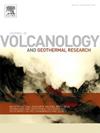巨型海底熔岩穹窿的脱气、孔隙和水化年龄特征:对日本Kikai火山口后火山活动的启示
IF 2.3
3区 地球科学
Q2 GEOSCIENCES, MULTIDISCIPLINARY
Journal of Volcanology and Geothermal Research
Pub Date : 2025-08-11
DOI:10.1016/j.jvolgeores.2025.108427
引用次数: 0
摘要
位于日本西南部的海底Kikai火山口在7.3 ka发生了一次火山口形成喷发。它随后的后火山口火山活动包括陆上沉积物的海底喷发,以及历史上从海底喷口形成的岛屿喷发。海洋调查还记录了一个巨大的,32平方公里的海底圆顶,在火山口后时期被放置在火山口底部,但其喷发的时间和方式尚不清楚。在这里,我们利用海底观测和在疏浚调查期间收集的岩石样本来研究这个巨大的海底穹顶。圆顶由大块石块覆盖;根据孔隙度、基质玻璃挥发性成分和热消磁数据,我们推断这些是在下沉之前在海面上热漂浮的巨大浮石。由于没有合适的放射性碳材料,我们转而使用巨型浮石基质玻璃的二次水化程度来估计喷发年龄,得出的年龄为公元13世纪或更年轻。我们推断,圆顶既在薄沉积物覆盖下内生生长,也通过外源海底熔岩流生长,而巨大的浮石是由熔岩上的浮石壳形成的。我们还发现了初步的结构证据,表明这个浅层海底穹丘是由隐蔽的破碎和火山碎屑烧结形成的,正如我们所提出的海底硅熔岩。总之,我们的发现表明,Kikai火山口在其目前的后火山口火山阶段有很高的平均喷发率,而海底喷口的潜在爆炸性喷发构成了这次活动的很大一部分。本文章由计算机程序翻译,如有差异,请以英文原文为准。
Degassing, porosity and hydration age characteristics of a giant submarine lava dome: Implications for post-caldera volcanism of the Kikai caldera, Japan
The mostly submarine Kikai caldera in SW Japan underwent a caldera-forming eruption at 7.3 ka. Its subsequent post-caldera volcanic activity has included subaerial eruptions whose onland deposits have been well studied, and a historical island-forming eruption from a submarine vent. Marine surveys have also documented a giant, 32 km3 submarine dome that has been emplaced on the caldera floor during the post-caldera period, but the timing and style of its eruption is not known. Here we investigate this giant submarine dome using seafloor observations and rock samples collected during dredging surveys. The dome is covered by large blocks; based on porosity, matrix glass volatile contents and thermal demagnetisation data we infer that these are giant pumice that floated hot at the sea surface prior to sinking. Without suitable radiocarbon material we instead use the extent of secondary hydration of giant pumice matrix glasses to estimate eruption age, yielding an age of 13th Century CE or younger. We infer that the dome grew both endogenously under a thin sediment covering and also via exogenous seafloor lava flow, and that the giant pumice formed from a pumiceous carapace on this lava. We also find preliminary textural evidence that this shallow submarine dome was formed by cryptic fragmentation and pyroclast sintering as is proposed for subaerial silicic lavas. Together our findings suggest that the Kikai caldera has a high average eruption rate in its current post-caldera volcanic stage, and that eruptions, potentially explosive, from submarine vents comprise a significant portion of this activity.
求助全文
通过发布文献求助,成功后即可免费获取论文全文。
去求助
来源期刊
CiteScore
5.90
自引率
13.80%
发文量
183
审稿时长
19.7 weeks
期刊介绍:
An international research journal with focus on volcanic and geothermal processes and their impact on the environment and society.
Submission of papers covering the following aspects of volcanology and geothermal research are encouraged:
(1) Geological aspects of volcanic systems: volcano stratigraphy, structure and tectonic influence; eruptive history; evolution of volcanic landforms; eruption style and progress; dispersal patterns of lava and ash; analysis of real-time eruption observations.
(2) Geochemical and petrological aspects of volcanic rocks: magma genesis and evolution; crystallization; volatile compositions, solubility, and degassing; volcanic petrography and textural analysis.
(3) Hydrology, geochemistry and measurement of volcanic and hydrothermal fluids: volcanic gas emissions; fumaroles and springs; crater lakes; hydrothermal mineralization.
(4) Geophysical aspects of volcanic systems: physical properties of volcanic rocks and magmas; heat flow studies; volcano seismology, geodesy and remote sensing.
(5) Computational modeling and experimental simulation of magmatic and hydrothermal processes: eruption dynamics; magma transport and storage; plume dynamics and ash dispersal; lava flow dynamics; hydrothermal fluid flow; thermodynamics of aqueous fluids and melts.
(6) Volcano hazard and risk research: hazard zonation methodology, development of forecasting tools; assessment techniques for vulnerability and impact.

 求助内容:
求助内容: 应助结果提醒方式:
应助结果提醒方式:


